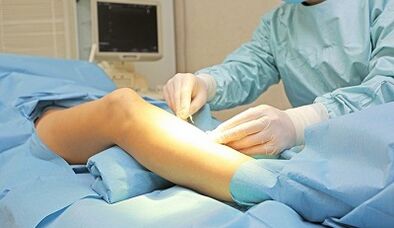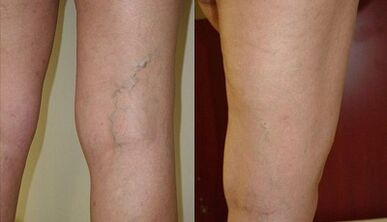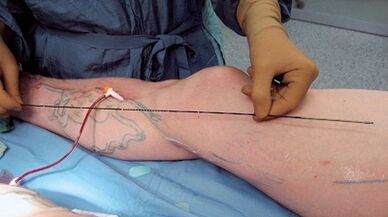Conservative treatments are only effective in the initial stages of varicose veins.Since the first symptoms are often not taken seriously, the pathology continues to develop, thereby reducing the effectiveness of the medications used.If symptoms worsen significantly, the only option to remove varicose veins is surgery.Rehabilitation occupies a special place, requiring patients to adhere to medical advice.
Indications for surgery

If varicose veins are present, surgery may be necessary in some cases.
In particular, surgical intervention is indicated for patients with:
- Extensive vascular damage, which can be determined by visual inspection;
- Symptoms include swelling, persistent pain, and a feeling of heaviness;
- Significant risk of thrombophlebitis, trophic ulcers.
Varicose vein surgery is appropriate when medication fails to achieve the desired results.It is important to prevent the disease from progressing to the point where surgical treatment is ineffective.
Surgery for varicose veins in the legs may be contraindicated in some patients.
Contraindications
Surgery in the final stages is often inappropriate; therefore, varicose veins are treated with various medications.They help slightly reduce the severity of the disease but cannot completely eliminate it.
Patients with:
- Inflammatory skin diseases (such as erysipelas or eczema) at sites of venous lesions;
- cardiovascular disease (coronary artery disease, hypertension, heart failure);
- Acute forms of phlebitis;
- Infectious diseases (can undergo surgery after recovery);
- Venous thrombosis, pulmonary embolism (history);
- Eliminates atherosclerosis in the blood vessels of the lower limbs.
Surgical treatment to eliminate varicose veins is contraindicated in patients over 70 years of age and pregnant women.
Preparing for surgery
A consultation with a phlebologist will help you properly prepare for your upcoming surgical treatment.Patients have the right to ask any questions of interest regarding the surgery.
You should also describe the symptoms you are experiencing as accurately as possible, talk about possible intolerances to certain medications, and be sure to inform about any medications you are currently taking.
The attending physician recommends that the patient undergo a series of diagnostic procedures:
- blood and urine tests;
- Fluorography;
- electrocardiogram;
- Duplex ultrasonography.
Certain conditions need to be met during the preparation phase:
- Three days before surgery, patients must adhere to a residue-free diet, that is, fried, salty, spicy, meat and flour products are prohibited.
- The last meal and fluid intake was 8 hours before surgery.
- You should forget about alcohol and cigarettes for at least three days.
- You will need to remove hair from the leg where the surgery will be performed, and you should use a razor.
- You must notify your doctor if ulcers, hematomas, or any skin lesions occur.
If the patient drives, arrange for someone close or familiar to pick him up after discharge.Driving is currently prohibited.
When preparing for surgery, the patient is interested in which type of surgical intervention is suitable for him and how much such treatment will cost.If a patient is scheduled for venous surgery, the price is affected by several factors: stage of the disease, length of blood vessels affected by varicose veins, anesthesia, etc.
How to get rid of varicose veins
Because there are many surgical treatments for varicose veins, the choice of a specific technique is based on diagnostic data.In some cases, the veins are partially or completely removed, while in other cases, veins deformed by varicose veins are sealed or narrowed using special substances.
phlebectomy
A surgical treatment in which areas of blood vessels containing varicose veins are removed.After removal, blood movement will occur through the deep veins.
The operation process is as follows:
- Once the anesthesia has taken effect, the surgeon will make a small incision (up to 5 mm).
- A special probe is used to remove the vein and then the affected area is excised.
The duration of phlebectomy is 1-2 hours.Subsequently, a small scar was left at the surgical site.
microphlebectomy

Excellent alternative to previous methods.The essence of this technique is that no 5 mm incision is required.A small puncture is enough to perform all necessary operations on the vein.Moreover, recovery in this case is much faster and leaves no scars.
All types of surgery to eliminate varicose veins in the legs go well, but in rare cases can cause complications.
Thanks to this puncture technique, even large varicose veins can be eliminated.
peel off
This is a type of phlebectomy.With its help, the main trunk of the great saphenous vein is removed.The surgeon uses a special probe to pull out the blood vessels affected by varicose veins through a small incision.Incisions are made in the inguinal fold and medial ankle area.
Stripping occurs:
- partial– Only part of the veins are removed;
- total– The diseased vein and its small branches are stretched.
Performing such procedures requires the utmost care from a physician.If at least one uncrossed tributary is present, the risk of recurrence increases significantly.
Sclerotherapy
This is a minimally invasive procedure to remove progressive varicose veins that does not require any incisions.The surgeon's goal is to narrow the lumen of the diseased blood vessel until it disappears completely.
To do this, a sclerosing agent is injected into the vein.The drug causes irreversible damage to blood vessel walls and subsequent luminal overgrowth.
Medications designed specifically for this purpose are usually used.
Sclerotherapy has several advantages:
- The procedure can be performed on an outpatient basis;
- The patient is allowed to resume daily activities the next day;
- No need for general anesthesia;
- There are no scars after the surgery.
The disadvantage is the possibility of varicose veins re-forming.This disease affects the veins near the vein where the sclerosing agent was injected.Up to 10 injections can be given in one procedure, and the treatment duration is approximately one hour.
What should be said are the types of sclerotherapy:
- Foam.The drug used forms a foam in contact with air, filling the cavity of the container.Closure of the lumen occurs within a short time and even a small amount of sclerosing agent is sufficient.In addition, to obtain satisfactory results, 1-2 procedures are required, during which a maximum of 3 foam injections are required.
- Microsclerotherapy.This technique is suitable for the initial stages of the disease.
- Echo hardening.For deep vein lesions.The injection is done using an ultrasound scanner, which makes it possible to clearly distinguish the injection site of the sclerosing agent, accurately determine the amount of the drug, and avoid adverse consequences.
The procedure performed is virtually painless and the patient recovers quickly thereafter.
laser coagulation
This method of treating varicose veins is called intravenous (within blood vessels) laser coagulation (occlusion) and involves the use of a special device - a laser LED.
It is injected into the affected vein, and due to its radiation, the inner surface of the vessel is welded together.Blood continues to circulate through healthy veins, and the patient's health improves.
Advantages of laser coagulation:
- No scars or age spots on the skin;
- Clinic lasts 1-2 hours;
- Use local anesthesia;
- The operation is performed under the control of an ultrasonic machine;
- Recovery period is short.
Whether the operation is successful or not will not be judged until 3 months later.The use of laser guarantees complete remission of the disease without the risk of recurrence.
Recovery period after phlebectomy
After surgery, patients must follow certain rules, which will minimize the risk of complications and speed up recovery:

- Compression stockings are recommended.The attending physician will help him make his choice.Initially (about 5 days), underwear is not removed before going to bed, and subsequently only during the day.
- To support blood vessels, drinking and smoking should be avoided, as nicotine and alcohol are among the most common causes of varicose veins.
- You should avoid excessive physical activity.Even minor injuries to the lower extremities can be dangerous.If the patient liked to exercise before, he can resume exercise after 1.5-2 months.
- To prevent recurrence, water procedures should not be overheated.The use of saunas, steam rooms and solariums is prohibited.
- Cosmetic surgery cannot be performed at the surgical site.
- It will be helpful to engage in therapeutic exercises.
To prevent varicose veins from returning after surgery, you will need to take medications prescribed by your doctor to help your blood vessels heal during your recovery period.Changing medication doses at your own discretion is not advisable and can have adverse consequences.If you experience any signs of deterioration, be sure to see a phlebologist immediately.
The type of surgical intervention depends on the individual characteristics of the disease.
Possible complications after surgery
No expert can guarantee that there will be no side effects after surgery.Complications may occur depending on the surgical treatment used.
Phlebectomy and stripping may result in:
- numbness in lower legs;
- Reduced skin sensitivity;
- pain syndrome;
- bleeding;
- hematoma;
- Suppuration at the surgical site.
After sclerotherapy, the following may occur:
- swelling of ankles and feet;
- Pigmentation;
- peeling, itching;
- painful feelings;
- Skin burns.
If a laser LED is used, then:
- inflammation;
- Darkening of areas of skin;
- minor bruising;
- Lingering pain.
The most dangerous complication of any surgical procedure is thrombosis.However, this has been observed in rare cases.With minimally invasive surgery, the risk of blood clots is quite low.
With surgical treatment, serious disease can be successfully eradicated.The main thing is to find a qualified specialist and not to ignore medical advice regarding the recovery period.

















